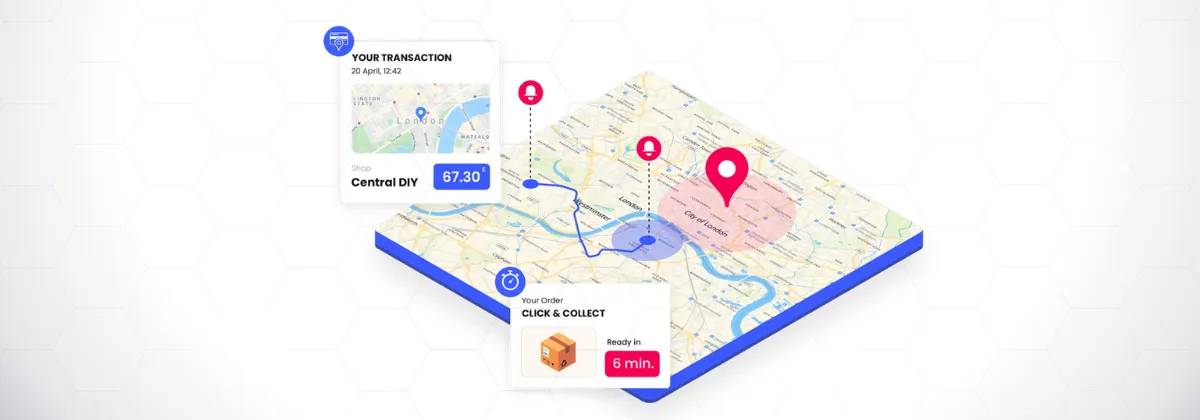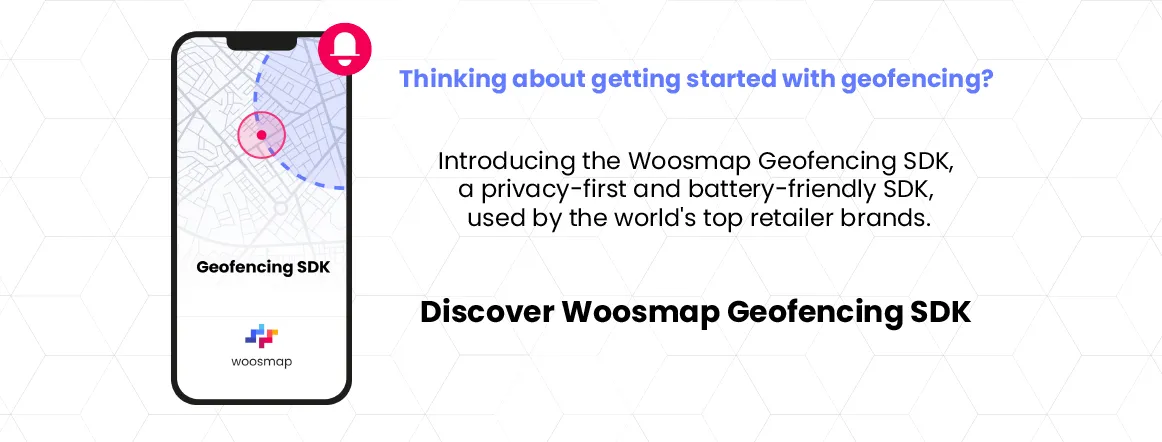Click and Collect: Why brands need it and how geofencing maximises the experience

Click and collect is not a new shopping format. But its popularity among shoppers has surged during the pandemic. Retailers now understand that this consumer trend is likely to stick and need to integrate it in a more global reflection about hybrid e-commerce. Yet brands still need to understand the full benefits of click & collect and its underlying technologies. Like geofences that open new possibilities for brands to anticipate consumer expectations. Because geofencing maximises the potential of geolocation and geo-tracking without compromising consumers' privacy.
What is click and collect?
Click&collect is a hybrid e-commerce model that enables consumers to purchase items online and physically pick them up later, in-store or at a collection point. Some brands go further than the “Buy Online, Pick Up in Store” (BOPIS) model to offer a seamless retail customer experience. They propose curbside pickup where customers can collect their online purchases without stepping out of their car. Among the major US retailers now offering curbside pickup: Nordstrom, Target, Walmart, and CVS.
The growth of click and collect and curbside pickup
It is difficult to evoke click&collect without mentioning the context of Covid-19. Because before 2020 the ability to pick up groceries or shopping items - without entering a shop or having interactions with employees - was a nice to have service, in a multichannel e-commerce strategy. But overnight, with quarantine and social distancing, this convenience became a necessity for safe shopping.
In the USA, before the pandemic, click&collect shares represented 15% of orders. It rose to 25% in 2020, with a 65% share increase. In 2022, curbside pickup still represents the majority of those shares. It accounts for 20% of online orders for US retailers offering this service. (Adobe US consumers report)
In the UK, 41% of retailers now offer click-and-collect services. And among those, it represents 40% of their sales. For the entire UK retail industry, click and collect accounts for 8.4% of the total retail sales. (2022 Barclays study “What’s in store for retail?”)
What are the benefits of click and collect?
This hybrid e-commerce model benefits both retailers and consumers. Therefore, it is important to consider a click-and-collect strategy from both points of view. To imagine services that could bring the most value.
Benefits for consumers
Click and collect is a convenient and time-saving alternative to shopping in a physical store. It also saves shipping costs usually associated with online deliveries.
More than 80% of consumers expected to be able to pick up their Click & Collect order in under 10 minutes, with 27 percent expecting less than four minutes.
Benefits for retailers
What is a benefit for consumers is a gain for retailers. Because adding click & collect options gives more choice and flexibility to consumers. It makes them more likely to order from the brand and switch delivery choices depending on their constraints of the day.
A cost-saving strategy can also motivate click and collect approaches. Because retailers can optimise their own delivery costs, and reduce their fleet of trucks or the costs of a third-party transport company.
How does click and collect work?
The transformation of the purchasing journey with click and collect scenario relies on the rise of the use of smartphone equipment. Indeed, the number of searches for local shops on smartphones has increased 30-fold over the past ten years and continued to increase in 2022.
78% of consumers use their smartphones to find information about a local shop.
That’s why it is important to consider mobile web-to-store scenarios where brands can maximise the potential of geolocation and geo-tracking to anticipate consumer expectations. With this approach, which integrates the physical part of the consumer journey, retailer need to be able to automate their services and personalise their customer experience.
Geofencing is the ideal solution for this e-commerce automation approach. This technology also offers solid privacy protection protocols to ensure the protection of consumers’ private geolocation information.
Optimize your Click and Collect with Geofencing
What does Geofencing means?
Geofencing is the creation of a virtual geographic boundary that allows software programs to automatically create a trigger-like response when a user enters or leaves a given area. It aims to improve customer experience by automating the sending of notifications to the back office and to customers.
The time is right to introduce geofencing in e-commerce experiences. Because consumers now see the Internet of Things, smartwatches and smart cars becoming commonplace. And because 82% of customers are willing to share their geolocations in exchange for consumer benefits (Mediametrie study).
What are the main uses of geofencing in retail?
Geofencing ad targeting might be the most known example of a strategy using geo-tracking technologies. But it is in fact the tree that hides the forest. Because geofences can also integrate into more advanced strategies that improve the customer experience and the fluidity of e-commerce processes.
Marketing campaigns: yes geofencing enables to targets ad based on location, personalise customer communications and offer more services. But in addition, geofencing is another incentive for users to engage with a brand’s app. Because knowing the context of the consumer is key to the relevance of marketing messages.
Consumer trend analysis: by integrating geofencing in their strategy, marketers can ensure better customer segmentation, thereby improving the CRM.
Click & Collect: geofencing can be part of a process to automate order preparation and reduce waiting times and investment in expensive hardware.
The proven efficiency of contextual marketing campaigns
SMS sent as part of a marketing campaign have a 98% open rate and 90% are read within 3 minutes of receipt. These “calls to action” have even more impact when they relate to the consumer’s local geographical area.
How does Geofencing work?
Standard geofencing detects when the user enters or leaves a designated geographical area, based on the activation of networks by a mobile device. This localisation uses networks like GPS (Global Positioning System), RFID (radio frequency identification), Wi-Fi, or cellular data. A combination of those technologies can also be used to track a device.
Geofences can be placed in proximity to any location. From the brand’s stores to partner venues, landmarks or even competitors' locations.
But basic geofencing has limitations. For instance, excessive notification can reflect negatively on a brand image. It can also irritate consumers if an ad pops up whenever they walk past a certain venue. Geofencing also requires real-time data that generates data consumption costs on the server side.
Privacy concerns can also arise around the use of geofencing. That’s why privacy legislations (GDPR in Europe and CCPA in California), allow geofencing only when users opt-in to tracking and agree to notifications.
Geofencing: how does it work?
To set up a “traditional” geofence, brands simply need to add a geofencing software development kit (SDK) to their application. It will then manage the chosen geographical areas. Users just need to allow push notifications from the app and the sharing of their geolocation.
But a geofencing 2.0 SDK goes further. It analyses the smartphone’s location data in real-time, without the need for a server, in order to identify various metrics. Such as:
- User’s proximity to a service offered by the brand
- Estimated Time of Arrival (ETA) to collect an order
- Recurrent visits to a particular place by the user
The SDK analyses these data directly on the smartphone and then shares it with the company’s back office to trigger an event - from preparing an order to sending a personalised promotional notification.
Woosmap's Geofencing solutions
A local and personalised customer experience
Local push notifications are effective because they are personalised and automatic. However, be careful to avoid certain pitfalls which could lead to lost customers. Follow these three recommendations when using geofencing:
- Energy-saving technologies: some applications’ push notifications require a constant Internet connection. Instead, focus on technologies which won’t drain your users’ batteries.
- Actionable data: use, in the app, data of the SDK to improve the customer experience throughout the buyer’s journey.
- Targeted action: send a genuine call-to-action based on the customer’s geolocation, rather than a generic advert. For example, advertise a special promotion in your customer’s usual shop.
Use cases for a local and personalised customer experience
Starbucks
Starbucks uses geofencing to send push notifications to their clients when they are in the neighbourhood of their coffee shops. For instance, when it’s the “happy hour” time, their app users receive a notification, informing them about the ongoing promotions, i.e., half-priced drinks or other special offers, and inviting them to stop by.
Apple Store
Premium and luxury brands use geofencing in order to upgrade their service level. Apple’s dedicated application enables customers to make an appointment with an advisor and sends an automatic notification when the customer approaches the shop.
Luxury brands
Other lavish brands are pushing the concept even further: sales associates are immediately informed about VIPs' shopping profiles and their preferences, upon their arrival at the store. Since personal insights are key when offering a high-end experience, this helps improve the “white-glove, high-touch” service.
Mass advertising is old-fashioned - brands use location to create unique, personalised and seamless experiences by communicating with your customers at the right time and in the right place.
Fast food industry
Click & Collect has become the norm for fast food restaurants. In the post-Covid-19 world, restaurant owners need to ensure the safety of their customers and employees, without compromising operations or revenues. Geofencing 2.0 further enhances this experience.
One of the largest American companies in the fast-food sector, a client of ours - launched its Click & Collect service in August 2021. Now, its customers’ orders are sent to the kitchen as soon as they physically approach the restaurant. They no longer need to queue up in or outside a store or a kiosk, enter a code or wait for orders to be prepared. Upon the customer’s arrival, the order is ready!
Geofencing removes the need for physical kiosks to place orders, with 3 key benefits:
- Less time spent waiting in restaurants
- A drastic reduction in public-health risks
- Reduced costs for the roll-out of kiosks
In general, placing an order with an app with geofencing 2.0 results in a 20% increase in the number of orders.
Conclusion
Click and collect and Curbside pickup require both digital and organisational elements. The automation of notifications, with a geofence, appears as the next evolutionary step towards those hybrid retail strategies. Furthermore, once they master geolocation services, retailers can build an even smoother and more efficient customer journey.
